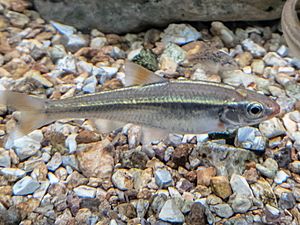Bleeding shiner facts for kids
Quick facts for kids Bleeding shiner |
|
|---|---|
 |
|
| Conservation status | |
| Scientific classification | |
| Synonyms | |
|
Notropis zonatus |
The bleeding shiner (Luxilus zonatus) is a cool freshwater fish. It's a type of minnow, which belongs to the same family as carps. You can find this fish in rivers and streams in southern Missouri and northeastern Arkansas. It loves clear, rocky, and sandy parts of small rivers and creeks.
Contents
What Does the Bleeding Shiner Look Like?
The bleeding shiner has an olive-brown back with a wide, dark stripe down its middle. Its sides are shiny and metallic. It also has two black stripes with a golden stripe in between them. One of these black stripes goes all the way to its nose! The fish's belly is a silvery white color.
When male bleeding shiners are ready to breed, they get bright red markings on their head, body, and fins. This makes them look even more colorful!
These fish are usually about 4 inches (10 cm) long. The biggest ones can grow up to 4.75 inches (12 cm) long.
Where Do Bleeding Shiners Live?
You can find bleeding shiners in many rivers across the Ozark Plateau. Some of these rivers include the St. Francis, Black, Meramec, and Gasconade Rivers.
Bleeding shiners really like clear streams and rivers that have gravel at the bottom. They are very rarely found in muddy streams.
What Do Bleeding Shiners Eat?
The bleeding shiner mostly eats insects and tiny water creatures. It finds these snacks on the surface of the water or as they float by in the current.
Because bleeding shiners have large eyes, scientists think they use their sight to find most of their food.
How Do Bleeding Shiners Reproduce?
Bleeding shiners usually lay their eggs in nests or small pits that other fish, often other minnows, have already made in the gravel. Many bleeding shiners, sometimes up to a hundred, gather in these spots to lay their eggs.
How Long Do Bleeding Shiners Live?
Most bleeding shiners do not live for more than three summers. They have a relatively short lifespan.
Are Bleeding Shiners Endangered?
The population of bleeding shiners seems to be slowly decreasing over the last 10 years, but this is not certain. However, there are still many of them throughout the areas where they live.
Sometimes, bleeding shiners have moved into new areas, like the Clear Creek system, where they weren't found before.
See Also
 In Spanish: Luxilus zonatus para niños
In Spanish: Luxilus zonatus para niños


